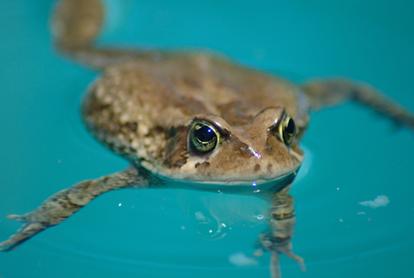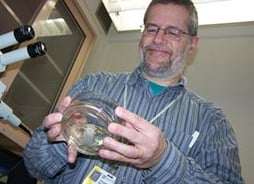
Researchers at the University of Rochester School of Medicine are using a special breed of frogs to study human diseases such as cancer. It turns out our amphibious friends have a lot to teach us about how tumors grow.
The University of Rochester is home to the world's largest resource of South African clawed frogs, also known Xenopus laevis, which are used for biomedical and immunological research.
Jacques Robert, Ph.D. professor of Microbiology and Immunology, coordinates the Xenopus Research Resource, which provides animals, materials, and training for researchers around the world. This resource is funded by the National Institute of Allergy and Infectious Diseases.
 Dr. Robert also works as the Principal Investigator at the Jumping Frog Lab. His lab's cancer research includes using Xenopus laevis to better understand how tumors grow and how the body reacts. “We still have a lack of understanding of the environment inside tumors,” said Dr. Robert. “A tumor is not just tumor cells, there are a lot of normal cells from the invaded organ and immune cells that infiltrate the tumor – and all of this changes as the tumor grows. We need to analyze this in real time.” One advantage to using tadpoles is their transparent skin, which makes them an extremely useful model for imaging tumors as they grow.
Dr. Robert also works as the Principal Investigator at the Jumping Frog Lab. His lab's cancer research includes using Xenopus laevis to better understand how tumors grow and how the body reacts. “We still have a lack of understanding of the environment inside tumors,” said Dr. Robert. “A tumor is not just tumor cells, there are a lot of normal cells from the invaded organ and immune cells that infiltrate the tumor – and all of this changes as the tumor grows. We need to analyze this in real time.” One advantage to using tadpoles is their transparent skin, which makes them an extremely useful model for imaging tumors as they grow.
According to the University of Rochester’s Newsroom, “Dr. Robert and his colleagues transplanted tumor cells into tadpoles, which developed into semi-solid tumors that spread throughout the tadpole over the course of a few weeks.”
This research may shed new light on a protective mechanism that tumors use - targeting a few specific immune cells to suppress the rest of the immune system and allow tumor growth. In addition, these studies on tadpoles might also help scientists understand how tumors grow blood vessels, which make it possible for them grow and thrive. This research could uncover ways to inhibit vessel growth within a tumor so it will starve. It may also lead to finding more effective methods of delivering chemotherapies.
Frogs many seem to be an unlikely study model; however, internally their anatomy is basically similar to most mammals, including humans. Just as importantly, frogs are similar to humans on a genetic level. The reason Xenopu laevis are particularly useful to researchers is the ease of which they can be be induced to breed in the laboratory by injecting human gonadotrophin. This has led to the amphibian becoming the model of choice for research in all sorts of biological fields.
Dr. Robert’s “Jumping Frog Lab” is just one of the many research labs at the University of Rochester Medical Center. URMC is home to more than 250 centers, institutes and labs, with a research faculty of over 1,400. These researchers work on projects that span across the biomedical disciplines, from fundamental to translational and clinical sciences.
On Thursday, April 7th 2016, Biotechnology Calendar Inc. will host the 1st Annual BioResearch Product Faire™ at the University of Rochester. This event will allow researchers to meet face to face with laboratory equipment suppliers who will demonstrate the latest advancements in the tools of their trade and fulfill the researchers' equipment needs. Researchers and science professionals are invited to attend for free. Suppliers interested in taking advantage of this unique networking opportunity should contact Biotechnology Calendar Inc. at (530) 272-6675 or click the link below for more information.




